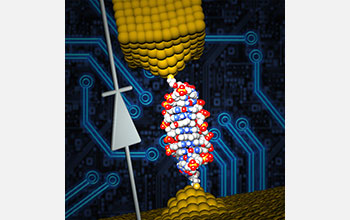Multimedia Gallery
Single molecule of DNA used to create world’s smallest diode
A research team from the University of Georgia and Ben-Gurion University in Israel site-specifically inserted a small molecule named coralyne into DNA and was able to create a single-molecule diode, which can be used as an active element in future nanoscale circuits.
More about this image
A research team from the University of Georgia (UGA) and Ben-Gurion University in Israel has demonstrated for the first time that nanoscale electronic components can be made from single DNA molecules.
According to lead author Bingqian Xu, an associate professor in the UGA College of Engineering and an adjunct professor of chemistry and physics, the finding may eventually lead to smaller, more powerful and more advanced electronic devices.
"If silicon-based chips become much smaller, their performance will become unstable and unpredictable," says Xu.
Seeking a solution, Xu turned to DNA, which he says is a good candidate for the design of functional electronic devices using single molecules because of its predictability, diversity and programmability.
Xu and his collaborators at Ben-Gurion used a single molecule of DNA to create the world's smallest diode--a component in electronic devices that allows current to flow in one direction but prevents its flow in the other direction.
After isolating a specifically designed, single duplex DNA of 11 base pairs, Xu and a team of UGA graduate assistants connected it to an electronic circuit only a few nanometers in size. The measured current showed no special behavior, so the team site-specifically inserted a small molecule named coralyne into the DNA. The team found that the current flowing through the DNA was 15 times stronger for negative voltages than for positive voltages, a necessary feature of a diode.
"Our discovery can lead to progress in the design and construction of nanoscale electronic elements that are at least 1,000 times smaller than current components," Xu said.
The study represents a promising advance in the search for a replacement for the silicon chip.
The research was supported by a grant from the National Science Foundation (grant ECCS 12-31967).
To learn more, see the UGA news story UGA researchers use single molecule of DNA to create world’s smallest diode. (Date image taken: 2016; date originally posted to NSF Multimedia Gallery: Aug. 5, 2016)
Credit: Bingqian Xu, College of Engineering, University of Georgia
Images and other media in the National Science Foundation Multimedia Gallery are available for use in print and electronic material by NSF employees, members of the media, university staff, teachers and the general public. All media in the gallery are intended for personal, educational and nonprofit/non-commercial use only.
Images credited to the National Science Foundation, a federal agency, are in the public domain. The images were created by employees of the United States Government as part of their official duties or prepared by contractors as "works for hire" for NSF. You may freely use NSF-credited images and, at your discretion, credit NSF with a "Courtesy: National Science Foundation" notation.
Additional information about general usage can be found in Conditions.
Also Available:
Download the high-resolution JPG version of the image. (2.0 MB)
Use your mouse to right-click (Mac users may need to Ctrl-click) the link above and choose the option that will save the file or target to your computer.

